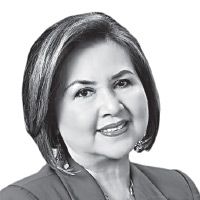Philippine basic education curriculum – not up to par

In 2004, DepEd Sec. Edilberto de Jesus helped me inaugurate the UNESCO EFA Dakar Pilot School for quality education in Pulung Bulu Elementary School, Angeles, Pampanga. I was then UNESCO secretary general and had already signed a MOA with Region 3 director Dr. Vilma Labrador to answer the call of UNESCO for upgrading the traditional public school. The existing 11 traditional grade school teachers had to be retrained in the Montessori Pagsasarili System. The pilot lasted 17 years, using English as the medium of instruction. At the conclusion of the pilot project, the 11 public school teachers reverted to the traditional public school system.
There are six spring-bound curriculum books of the Bureau of Elementary Education, Curriculum Development Division funded by the Third Elementary Education Project (TEEP) that I tried to study. Reviewing Heograpiya, Kasaysayan, Sibika at Kultura (Hekasi) gave me such a headache since Geography, History, Civic and Culture were all bundled in one book – in Tagalog.
All subjects, except Science and Health, Elementary Math and English, are in Tagalog, like Edukasyon Pangtahanan at Pangkabuhayan (Home Economics and Occupational Skills), Edukasyon sa Kagandahang Asal at Wastong Pag-uugali (Good Manners and Right Conduct) and Musika at Sining (Music and Arts) and Pagpapahalaga (Values Education).
The children’s efforts of understanding difficult concepts is further blocked by trying to comprehend Tagalog since their dialects are either Cebuano, Waray, Ilocano, Zambal, Chabacano, etc. Isn’t it easier to learn “hemisphere” instead of hating-globo, “universe” instead of sanlibutan, “channel” instead of lagusan, “strait” (Strait of Magellan) instead of kipot? We have to respect English as the universal language of education.
‘Fable of the Great River’
The Third Elementary Education Project for Grades I to VI deals with the subject on Human Body. This is fragmented into Grade I – the Body Parts; Grade II and III – the Senses; Grade IV – the Skeletal System; Grade V – the Reproductive and Respiratory Systems; Grade VI – the Circulatory and Nervous Systems. In great contrast is the EFA Dakar Cosmic Elementary Curriculum lessons of “The Great River” symbolizing the human body studied in Grade IV alone.
The Great River chart illustrates the river with several buildings around and narrates, “There was once a great river in a large nation. The citizens here work 24 hours daily. No one can stop working for it will mean the death of the nation. On both banks of the river are several departments: Departments of Transport, of Defense, of Sanitation, of Production, of Nutrition. At the head of the river is the Capitol Hall where the national leader sends messages regularly to the different ministries.”
Space Child Anakin Skywalker
As the Philippine UNESCO Social Science and Human Science Committee (with the collaboration of PSSC) suggested a storytelling format in the revision of the existing over simplified Social Studies textbooks, I am introducing the character of space child Anakin Skywalker, for he would certainly ignite the imagination of any child, even a barrio child who usually watches television or movies more than the local Adarna children’s book characters.
As Space Child Anakin zooms over the Earth closely, he observes, “I see Planet Earth has three blankets: the atmosphere (atmospera, according to Hekasi, as DepEd Science is taught in Tagalog), lithosphere (bahaging lupa) and the hydrosphere (bahaging tubig). Each layer has life – the biosphere that provides the basic needs of life. The Earthlings live on the land using houses and buildings. Their clothes are made of cotton or silk from the Plant Kingdom, as well as synthetic rayon and nylon from the Mineral Kingdom. Fish and birds from the Animal Kingdom provide the food. Therefore, man must protect the Animal, Plant and Mineral Kingdoms.”
The totem pole of humanity
Contrary to the K-12 DepEd Curriculum Guide stating that six- to 12-year-old grade school children are too young to understand advanced concepts and therefore must be provided with minimum knowledge, this stage of development is actually gifted with enormous reasoning power and a strong, flaming imagination. Thus the students can understand the four feet tall Totem Pole Chart of Man illustrated with the evolution of civilizations through seven stages – The Primitive Man is at the bottom, topped by the Village Man, followed by the Men of the Ancient Civilizations (Egypt, Rome, China), the highly cultured man of the Renaissance Era, the Colonizers (Explorers) of various empires, the Modern Man and, topping them all, the Space Man.
Let’s allow Space Child Anakin to imagine how each man’s needs evolved. “During the Primitive Era, man caught the animals with spears and ate them raw. He moved from place to place, hunting food from the land and waters. Then life changed when he discovered fire and began to cook. I can see special recipes developing during the ancient civilizations of Egypt, Greece and Rome.
“During the Monarchy Era, the king financed explorations. I see the expansion of several empires – England, France, Spain, etc. colonizing India, Vietnam and the Philippines. The explorers paved the way for the vast exchanges of botanical products, craftsmanship and culture. Europeans and Asians are exchanging ideas about cuisine, clothing, theater and religion. The discoveries of transportation, medicine and the printing machines advanced life. The ‘totem pole’ of humanity depicts the transition of human development from primitive times through different civilizations until Modern Man expands researches on his basic needs of food, clothing, shelter. Ultimately, Man reaches the Space Age.”
Thus today, we can say that we people of the 21st century owe much to the discoveries, struggles and sacrifices of all the men in the past.
‘May the force be with you’
Many wars have interrupted man’s progress. The major wars are called World Wars. Some have practically lost everything, but countries help each other as they band together in peace. More than 125 countries form this association called the United Nations.
Man has been preoccupied mostly with his material needs. Unfortunately, the DepEd curriculum does not refer to his spiritual needs such as religion, education and entertainment. The 2000 United Nations Millennium Report emphasized, “Human development is much more than the rise and fall of national income.” This year the UN 30 Agenda for Sustainable Development has extended the UNMDG (2000-2015) another 15 years to prod the developing countries to be economically self-sustainable by providing quality education. Life should always be in constant progression.
We should therefore listen to Anakin’s mentor, Obi-Wan Kenobi, to always keep in mind, “May the force be with you!”
* * *
Dr. Preciosa S. Soliven is the former Philippine UNESCO Nat Com Secretary General (1986-2010).
- Latest
- Trending



























